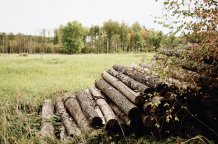
Monitoring helps communities find out how much forest is being cut down, punish those who cut too much and adjust norm and rules on forest use.
Community-led monitoring of deforestation might not reduce forest use overall, but merely displace it to unmonitored areas, a new study finds.
The peer-reviewed study, by researchers including Dr Sabrina Eisenbarth from the University of Exeter Business School, measured the impact of community-led forest monitoring on activities such as tree felling, domestic animal grazing and charcoal production in community managed forest in Uganda.
The year-long research project paid six community members from 60 communities to patrol the communal forest surrounding the village once a month.
The community monitors reported any threats to the forest every month and shared information with the wider community in village meetings, providing an opportunity for discussion around forest use and sustainability.
The research team evaluated the effect of this monitoring activity on forest use in both monitored and unmonitored areas.
They looked at a combination of detailed forest measurement on the ground and satellite data from the 60 communities and compared it to equivalent forest measurement in 50 control communities without systematic community-led monitoring.
The researchers found that community-led forest monitoring did not affect forest use overall. While forest loss decreased slightly in the monitored villages, amounting to 450m2 of forest per village, forest use in areas adjacent to those villages, where there was no or less monitoring, rose by 300% and 150% respectively – totalling an extra 12,600m2 of forest loss.
Nearly a third of forests across Africa, Asia and Latin America are now managed by local people and community forest management has been hailed as a powerful policy tool that could reduce deforestation – one of the main drivers of climate change.
Previous research has shown that communities can successfully manage their forests, but only if certain institutional features are in place – one of those features is community-led forest monitoring.
Monitoring helps communities find out how much forest is being cut down, punish those who cut too much and adjust norm and rules on forest use.
The research team had initially hypothesised that community monitoring would decrease forest use, with potential rule-breakers deterred by the fear of being caught and the information provided to community members driving a shift in norms over forest use, leading to a change in the official forest-use rules.
But one of the authors, Dr Sabrina Eisenbarth, a Lecturer in Economics at the University of Exeter Business School's Land, Environment, Economics and Policy (LEEP) Institute, said the fear of being caught was potentially moving the deforestation to other areas.
"We suspect that the increase in forest loss in unmonitored areas is, at least to some extent, driven by displacement of forest use by members of treatment villages due to fear of sanctions.
"If reductions in forest use are driven by a fear of being caught rather than self-restraint, community members could merely displace forest use outside of the monitored areas and accelerate deforestation in adjacent areas."
The research team say more attention is needed to the design of conservation programmes based on community monitoring in order to avoid displacement.
"If displacement is driven by a fear of sanctions, the design of a monitoring intervention might be improved if monitoring was more widespread or if community members could not predict which parts of the forest were unmonitored," said Dr Eisenbarth.
The researchers said the success of community-monitoring schemes ultimately depends on "community self-restraint", which might require changes in the norms and rules around forest use. The one-year community monitoring intervention did not lead to such norm-shifts.
'Can community monitoring save the commons? Evidence on forest use and displacement' by Dr Sabrina Eisenbarth, Louis Graham and Dr Anouk S Rigterink is published in the Proceedings of the National Academy of Sciences of the United States of America (PNAS).






